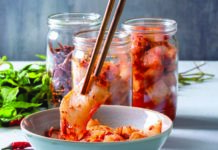
When your child spends more time scratching, sneezing, and wheezing than playing and adventuring, it can be hard to know how to help them with their allergies. While antihistamines and epinephrine have their place, incorporating diet and lifestyle strategies for allergy management may improve your child’s quality of life so they enjoy a more care-free childhood.
Understanding allergies
An allergy is the body’s abnormal reaction to an inherently harmless substance, known as an allergen, which is either breathed in, eaten, or touched.
Once the body marks the allergen as a dangerous invader, the body’s immune system kicks into gear upon exposure. Depending on the type of allergen, this immune activity can cause a range of symptoms in the head, respiratory tract, skin, and digestive system. Food allergy, atopic dermatitis (eczema), allergic rhinitis (hay fever), and asthma are diverse presentations of allergic disease, which often go hand in hand.
Inhaled allergens typically cause symptoms like watery eyes, congestion, runny nose, itchy palate, and sneezing, which may be diagnosed as allergic rhinitis. Inhaled allergens can also exacerbate allergic respiratory conditions, such as asthma.
Top inhaled allergies
- tree and grass pollen
- pet dander
- dust mites
- mold
- traffic-related air pollutants
Food allergens can cause digestive symptoms like nausea, vomiting, and diarrhea. However, severe food allergies can also manifest in the skin as urticaria (hives) and atopic dermatitis and are the most common trigger of potentially life-threatening effects like difficulty breathing, swollen throat, or rapid heartbeat, otherwise known as anaphylaxis.
Food intolerance vs. allergy
Food intolerances pertain to the digestive system, whereas food allergies recruit the immune system. Intolerance usually happens when the digestive system lacks enzymes to break down a food component—for example, the lactose in dairy products—causing symptoms like gas and bloating. Food allergy is an immune response to specific proteins in food, and it can manifest in many ways, including as anaphylaxis.
Key kid-safe supplements
Vitamin D
Deficiency in children is associated with suboptimal asthma control, increased severity of atopic dermatitis, and a higher prevalence of allergic rhinitis. Supplementation with vitamin D in children has been shown to significantly reduce symptoms of allergic rhinitis from grass pollen allergy, and some evidence shows a mild improvement in atopic dermatitis symptoms. You can find vitamin D included in kids’ fish oil supplements–plus, fish oil itself is associated with a decreased risk of food sensitization and food allergy in young children.
Probiotics
Supplementation with probiotics may improve the gut microbiome, which has been studied as a possible factor in the development of allergic disease. Certain strains of probiotics (B. longum, B. infantis, and B. breve) may also significantly improve symptoms and quality of life in children with pollen-induced allergic rhinitis and asthma.
Quercetin
A very popular part of natural allergy formulas, quercetin is a plant-derived antioxidant with anti-inflammatory properties. Of interest to allergy sufferers is evidence that quercetin can inhibit the body’s release of histamine, one of the main culprits for triggering allergy symptoms. Preliminary studies have shown that quercetin supplements may be useful in relieving symptoms.
Diet therapy
The most important treatment for food allergy is to identify the allergen and remove it from the diet completely. This can often be accomplished via skin prick testing administered by a health professional.
The hypoallergenic diet, aka the elimination diet, may also be helpful, depending on the severity of the allergic reaction. This diet systematically removes and then reintroduces the most commonly allergenic foods (see “Food Allergens”) to determine if they are
causing symptoms.
Nutritional adequacy for growing kids is difficult to achieve while on the hypoallergenic diet, so this method is also best performed under the guidance of your healthcare provider. Ask for a list of food and pollen cross-reactions, which can be the culprit behind allergic reactions without an apparent trigger. (For example, ragweed pollen and melons can cause a cross-reaction.)
Food allergens
The most common allergens are
- eggs
- milk
- tree nuts
- peanuts
- soybeans
- shellfish
- fish
- wheat
- sesame
Additional allergens and common causes of intolerence are
- strawberries
- corn
- tomatoes
- chocolate
What I wish every parent knew about supplements and food allergies
- Children with food allergies who are on the hypoallergenic diet have been found to be deficient in vitamin D, zinc, selenium, and calcium. Look for a children’s multivitamin to correct possible deficiencies.
- Some vitamins have allergenic additives, including artificial sweeteners, potato starch, corn, soy, and gluten. Look for products either labelled “free from” these ingredients or “hypoallergenic.” Currently, there’s no certification to protect these terms, so be sure to read the entire label.
- Children with food allergies have an increased risk for protein deficiency, so consider giving your child a hypoallergenic protein powder.
Make home an oasis
Keep the outdoors outside by keeping windows shut, particularly during high pollen and mold seasons, which you can track on your local weather network. When you walk in the door, immediately take off your shoes to avoid dragging environmental allergens through the house.
In both children and adolescents, asthma and allergic rhinitis are correlated with exposure to mold in their first year of life, so keep the home and basement at about
50 percent humidity to ward off mold.
Dust mites also thrive in high humidity, so a dehumidifier is likely a good investment. To keep dust mites at bay, regularly wash bedsheets; remove dust reservoirs like rugs, stuffed animals, and curtains from your child’s room; and regularly clean carpets with a HEPA filter vacuum cleaner, which is designed to trap allergens.
Soothing symptoms
Keep your child’s airways clear using a combination therapy of intranasal steroids and nasal saline, which is more effective than steroids alone for treating allergic rhinitis in kids. Look for natural sprays that use purified seawater or have minimal ingredients other than salt and water.
You can soothe eye allergies, swelling, and hives with a cold compress. Simply fill a bowl with ice water, submerge a cloth, wring out the excess, and apply directly to the affected area.
To take the itch out of atopic dermatitis, bathing with oatmeal is a useful and surprisingly soothing treatment that can reduce the need for prescription medication. Pour about 1/2 cup (125 mL) of gluten-free oats into an old stocking, tie it up, and put it in the tub while your child is bathing. Topical application of coconut oil is also effective for hydrating the skin and preventing bacterial infection of atopic dermatitis lesions, which can flare up from scratching.
Dr. Cassie Irwin, ND, is a functional medicine practitioner who consults virtually and in Vineland, Ontario, to optimize quality of life with autoimmunity and chronic illness: drcassieirwin.com and @drcassieirwin on Instagram.
This article was originally published in the August 2020 issue of alive Canada magazine, under the title “Take the sting out of your child’s allergies.”





